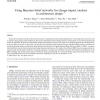Free Online Productivity Tools
i2Speak
i2Symbol
i2OCR
iTex2Img
iWeb2Print
iWeb2Shot
i2Type
iPdf2Split
iPdf2Merge
i2Bopomofo
i2Arabic
i2Style
i2Image
i2PDF
iLatex2Rtf
Sci2ools
JSS
2007
2007
Using Bayesian belief networks for change impact analysis in architecture design
Research into design rationale in the past has focused on argumentation-based design deliberations. These approaches cannot be used to support change impact analysis effectively because the dependency between design elements and decisions are not well represented and cannot be quantified. Without such knowledge, designers and architects cannot easily assess how changing requirements and design decisions may affect the system. In this article, we introduce the Architecture Rationale and Element Linkage (AREL) model to represent the causal relationships between architecture design elements and decisions. We apply Bayesian Belief Networks (BBN) to AREL, to capture the probabilistic causal relationships between design elements and decisions. We employ three different BBN-based reasoning methods to analyse design change impact: predictive reasoning, diagnostic reasoning and combined reasoning. We illustrate the application of the BBN modelling and change impact analysis methods by usin...
Design | Design Elements | Impact Analysis | JSS 2006 | JSS 2007 |
Related Content
| Added | 27 Dec 2010 |
| Updated | 27 Dec 2010 |
| Type | Journal |
| Year | 2007 |
| Where | JSS |
| Authors | Antony Tang, Ann E. Nicholson, Yan Jin, Jun Han |
Comments (0)

